E-segment
The E-segment is the second largest of the European segments for passenger cars, synonymous with the term executive car.[1][2][3]

(2015-present model shown)
_02.jpg.webp)
E-Segment is a niche in Europe (3% penetration in 2017).
Most E-segment cars are sedans/saloons, however several models are also produced in a wagon/estate body style.
European vs. American classification
The terms E-segment or executive car do not have a one-to-one equivalent in the American car classification. However, if a modern E-segment sedan by a European brand is sold in the U.S., it invariably falls into the category of a mid-size sedan, usually a mid-size luxury sedan. This is true, for example, for the BMW 5 G30 and the standard-wheelbase Volvo S90.
Conversely, the American mid-size sedan classification[note 1] spans both the D-segment and the E-segment. With size brackets of European car segments increasing, the Toyota Camry fell from the E-segment[4] into the D-segment while remaining a mid-size car.
European sales figures
Note: the table includes not only E-segment cars, but also a car fitting the F-segment in terms of size (the 2011 Chrysler 300).
| 2018 rank | Manufacturer | Model | 2013 sales | 2014 sales | 2015 sales | 2016 sales | 2017 sales[5] | 2018 sales[6] | % change (2017–2018) |
|---|---|---|---|---|---|---|---|---|---|
| 1 | Mercedes-Benz | E-Class | 106,559 | 99,565 | 84,771 | 99,494 | 127,638 | 117,906 | |
| 2 | BMW | 5 Series | 107,307 | 98,701 | 88,898 | 81,599 | 109,953 | 108,653 | |
| 3 | Audi | A6 / A6 allroad | 82,883 | 84,283 | 95,329 | 93,479 | 78,944 | 71,258 | |
| 4 | Volvo | S90 / V90 | — | — | — | 10,834 | 55,193 | 56,192 | |
| 5 | BMW | 6 Series | 8,549 | 7,880 | 7,370 | 5,732 | 5,610 | 10,703 | |
| 6 | Jaguar | XF | 20,414 | 20,609 | 16,416 | 16,024 | 12,501 | 10,375 | |
| 7 | Mercedes-Benz | CLS-Class | 15,139 | 10,289 | 12,600 | 7,803 | 5,116 | 9,113 | |
| 8 | Audi | A7 Sportback | 8,986 | 8,473 | 10,196 | 9,120 | 6,111 | 8,935 | |
| 9 | Porsche | Panamera | 5,679 | 5,676 | 4,191 | 3,140 | 10,478 | 9,454 | |
| 10 | Maserati | Ghibli | 339 | 4,238 | 4,644 | 4,124 | 2,981 | 2,534 | |
| 11 | BMW | 8 Series | — | — | — | — | — | 1,299 | New |
| 12 | Lexus | GS | 1,922 | 2,032 | 1,373 | 2,023 | 1,508 | 1,066 | |
| 13 | Lexus | ES | — | — | — | — | — | 217 | New |
| 14 | Lincoln | Continental | — | — | — | 5,261 | 12,012 | 8,758 | |
| 15 | Infiniti | Q70 | 339 | 145 | 560 | 484 | 362 | 64 | |
| 16 | Genesis | G80 | — | 163 | 228 | 131 | 49 | 30 | |
| 17 | Volvo | V70 / XC70 | 40,260 | 46,348 | 49,263 | 30,436 | 511 | 21 | |
| 18 | Chrysler/Lancia | 300C/Thema | 2,236 | 392 | 28 | 19 | 16 | 12 | |
| Total | — | — | — | — | — | 373,727 | 422,525 | 415,757 |
Current E-segment cars
The three highest selling E-segment cars in Europe are the Mercedes-Benz E-class, BMW 5 Series and Audi A6.[5]
 Audi A6 (1994-)
Audi A6 (1994-) BMW 5 Series (1972-)
BMW 5 Series (1972-) Jaguar XF (2007-)
Jaguar XF (2007-) Mercedes-Benz E-Class (1993-)
Mercedes-Benz E-Class (1993-) Volvo S90 (2016-)
Volvo S90 (2016-) Lexus ES (1989-)
Lexus ES (1989-)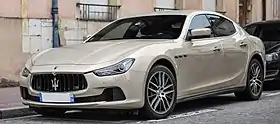 Maserati Ghibli (2013-)
Maserati Ghibli (2013-)
5-door models
 Audi A6 (1994-)
Audi A6 (1994-)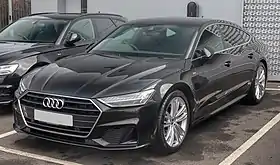 Audi A7 (2010-)
Audi A7 (2010-) BMW 5 Series Touring (1990-)
BMW 5 Series Touring (1990-) BMW 6 Series Gran Turismo (2017-)
BMW 6 Series Gran Turismo (2017-)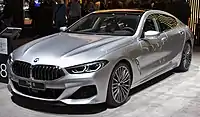 BMW 8 Series Gran Coupé (2017-)
BMW 8 Series Gran Coupé (2017-)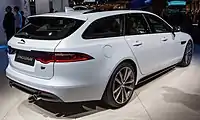 Jaguar XF (2016-)
Jaguar XF (2016-) Mercedes E-Class Estate (1993-)
Mercedes E-Class Estate (1993-)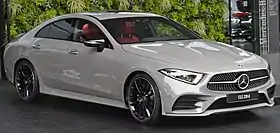 Mercedes-Benz CLS-Class (2004-)
Mercedes-Benz CLS-Class (2004-).jpg.webp) Mercedes-AMG GT 4-Door Coupé (2018-)
Mercedes-AMG GT 4-Door Coupé (2018-).jpg.webp) Porsche Panamera (2009-)
Porsche Panamera (2009-).jpg.webp) Porsche Panamera Sport Turismo (2016-)
Porsche Panamera Sport Turismo (2016-)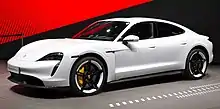 Porsche Taycan (2020-)
Porsche Taycan (2020-)_trimmed.jpg.webp) Tesla Model S (2012-)
Tesla Model S (2012-)_-_Toyota_MIRAI_CONCEPT.jpg.webp) Toyota Mirai (2014-)
Toyota Mirai (2014-) Volvo V90 (2016-)
Volvo V90 (2016-)
See also
Notes
- Also, the American full-size sedan classification does not have any equivalent in the European classification with the exception of full-size luxury cars which belong to the F-segment. As European segments denote both size and equipment level, American full-size cars that are not luxury cars simply do not belong to any of the European segments. Considering length only, they would always fall into the F-segment or even exceed its dimensions - with a possible exception of the 2018 Toyota Avalon which may or may not be short enough to be considered E-segment (this is as of 2019).
References
- "Regulation (EEC) No 4064/89 - Merger Procedure" (PDF). www.europa.eu.
- "Impact on the Competitiveness of the European Automotive Industry of Potential FTA with India and ASEAN" (PDF). www.europa.eu. p. 8. Archived from the original (PDF) on 29 April 2013.
- "Latest Safety Ratings". www.euroncap.com. Retrieved 8 January 2019.
- https://www.aerzteblatt.de/archiv/101649/Newcomer-in-der-oberen-Mittelklasse-Toyota-Camry
- "European sales 2017 Premium Large segment". www.carsalesbase.com. 18 February 2018. Retrieved 8 February 2019.
- "European sales 2018 Premium Large segment". carsalesbase.com. 2019-02-22. Retrieved 2019-05-04.
